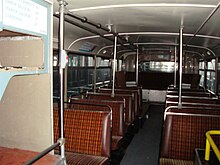Bristol VR
| Bristol VR | |
|---|---|

Preserved Southern Vectis Eastern Coach Works bodied Bristol VR in July 2008
|
|

Arriva Buses Wales Bristol VR interior
|
|
| Overview | |
| Manufacturer | Bristol |
| Body and chassis | |
| Doors | 1 or 2 |
| Floor type | Step entrance |
| Dimensions | |
| Length | 9400mm (9.5 m) to 10600mm (10.6 m) |
| Width | 2500mm (2.5 m) |
| Height | 13 ft 8 in (4.17 m) and 14 ft 6 in (4.42 m) |
The Bristol VR was a rear-engined double-decker bus chassis manufactured by Bristol as a competitor to the Leyland Atlantean and Daimler Fleetline.
The Bristol VR was originally designed for single-deck or double-deck bodywork. The design featured a longitudinal mounted engine set behind the rear offside wheels, rather than the more typical transverse layout. A choice of Gardner 6LX or 6LW engines or the Leyland O.600 engine were to be available. The transmission was a semi-automatic unit by Self-Changing Gears. Originally intended to be designated the Bristol N-type, the chassis became known as the Bristol VR, an abbreviation for Vertical Rear, a reference to the layout of the engine. Two lengths were available, 32 ft 9 in (9.98 m) and 36 ft (11 m), and these were designated VRS and VRL respectively. A drop-centre rear axle and low frame were employed to keep the height of the vehicle down.
Two prototypes were built in spring 1966, and were shown at the 1966 Earls Court Motor Show. This was the first show at which Bristol could exhibit since 1948, their products being available to the open market again. The prototypes had 80-seat bodies by Eastern Coach Works (ECW) and entered service with Central SMT and Bristol Omnibus Company.
In July 1967 Bristol introduced a new version, the VRT, with a more conventional transverse-engined layout. The chassis was only available as a double-decker. There was also a choice of two frame heights. The longitudinal mounted version remained, and became known as the VRL. However, in July 1968 the British government introduced a grant intended to modernise the British bus fleets, and speed-up the introduction of one-man operation. The standard specification for the grant required a transverse rear-engined vehicle, with the result that few VRLs were produced.
...
Wikipedia
